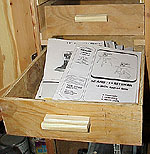This is a Veteran Owned site
Instruction ManualsBy Tom Hintz
For many, this message arrives too late. The instruction manuals provided with their woodworking equipment departed for points unknown with the boxes and packing material on the next trash day. For others, locating and reading long-forgotten manuals could lead to revelations, and better operating equipment. Women often apply a stereotype to men that essentially means we refuse to ask for directions. Though usually in reference to the temporary loss of destination while behind the wheel of an automobile, the concept can often be applied to the assembly of anything vaguely mechanical. Guys tend to minimize their need for guidance at times like this. In the fully real world, assembly instructions are very important, and should be followed precisely. If we expect a piece of equipment to perform well--and retain the manufacturer warranty--it must be assembled correctly. Conjuring up our own assembly sequence or procedures seldom impresses those who administer warranty claims. I have found remarkably useful information beyond the assembly pages as well. Tips and procedures for setting the machine up benefit the work we are able to produce with it. Equally important are warnings that when disregarded (or not read) could lead to injury, junk wood and ruined projects. When I first began building my woodworking shop in the "room" that used to house our cars, I constructed a large cabinet in which to store various supplies. I added a special large capacity drawer, specifically for the manuals that came with the equipment I anticipated adding. Since then, as each piece of equipment was assembled and set up, its manuals were placed in this drawer. Now, when I have a question about operating, setting up or repairing something in my shop, chances are I know exactly where all the manufacturers information is. If something is not performing right, I can also check the manuals for troubleshooting charts, or cruise the setup information looking for clues. If I need parts available only from the manufacturer, I at least have a good starting point for that information as well. This may seem like a minor point, but if the time comes when you are in need of a manual, and you know where it is, you just saved the day. Do you have a comment about this page? - Email Me! |
All written, photographic and drawn materials are property of and copyright by NewWoodworker.com LLC 2000-2019. Materials may not be used in any way without the written permission of the owner.

